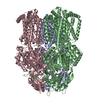+ データを開く
データを開く
- 基本情報
基本情報
| 登録情報 | データベース: PDB / ID: 8ffk | |||||||||||||||||||||||||||||||||||||||||||||||||||||||||||||||||||||
|---|---|---|---|---|---|---|---|---|---|---|---|---|---|---|---|---|---|---|---|---|---|---|---|---|---|---|---|---|---|---|---|---|---|---|---|---|---|---|---|---|---|---|---|---|---|---|---|---|---|---|---|---|---|---|---|---|---|---|---|---|---|---|---|---|---|---|---|---|---|---|
| タイトル | Klebsiella pneumoniae AcrB multidrug efflux pump apo form | |||||||||||||||||||||||||||||||||||||||||||||||||||||||||||||||||||||
 要素 要素 | Efflux pump membrane transporter | |||||||||||||||||||||||||||||||||||||||||||||||||||||||||||||||||||||
 キーワード キーワード | MEMBRANE PROTEIN / Klebsiella pneumoniae / AcrB multidrug efflux pump | |||||||||||||||||||||||||||||||||||||||||||||||||||||||||||||||||||||
| 機能・相同性 |  機能・相同性情報 機能・相同性情報efflux transmembrane transporter activity / xenobiotic transmembrane transporter activity / plasma membrane 類似検索 - 分子機能 | |||||||||||||||||||||||||||||||||||||||||||||||||||||||||||||||||||||
| 生物種 |  Klebsiella pneumoniae (肺炎桿菌) Klebsiella pneumoniae (肺炎桿菌) | |||||||||||||||||||||||||||||||||||||||||||||||||||||||||||||||||||||
| 手法 | 電子顕微鏡法 / 単粒子再構成法 / クライオ電子顕微鏡法 / 解像度: 2.82 Å | |||||||||||||||||||||||||||||||||||||||||||||||||||||||||||||||||||||
 データ登録者 データ登録者 | Zhang, Z. | |||||||||||||||||||||||||||||||||||||||||||||||||||||||||||||||||||||
| 資金援助 |  米国, 1件 米国, 1件
| |||||||||||||||||||||||||||||||||||||||||||||||||||||||||||||||||||||
 引用 引用 |  ジャーナル: mBio / 年: 2023 ジャーナル: mBio / 年: 2023タイトル: Cryo-EM Structures of the Klebsiella pneumoniae AcrB Multidrug Efflux Pump. 著者: Zhemin Zhang / Christopher E Morgan / Robert A Bonomo / Edward W Yu /  要旨: The continued challenges of the COVID-19 pandemic combined with the growing problem of antimicrobial-resistant bacterial infections has severely impacted global health. Specifically, the Gram- ...The continued challenges of the COVID-19 pandemic combined with the growing problem of antimicrobial-resistant bacterial infections has severely impacted global health. Specifically, the Gram-negative pathogen Klebsiella pneumoniae is one of the most prevalent causes of secondary bacterial infection in COVID-19 patients, with approximately an 83% mortality rate observed among COVID-19 patients with these bacterial coinfections. K. pneumoniae belongs to the ESKAPE group of pathogens, a group that commonly gives rise to severe infections that are often life-threatening. Recently, K. pneumoniae carbapenemase (KPC)-producing K. pneumoniae has drawn wide public attention, as the mortality rate for this infection can be as high as 71%. The most predominant and clinically important multidrug efflux system in K. pneumoniae is the acriflavine resistance B (AcrB) multidrug efflux pump. This pump mediates resistance to different classes of structurally diverse antimicrobial agents, including quinolones, β-lactams, tetracyclines, macrolides, aminoglycosides, and chloramphenicol. We here report single-particle cryo-electron microscopy (cryo-EM) structures of K. pneumoniae AcrB, in both the absence and the presence of the antibiotic erythromycin. These structures allow us to elucidate specific pump-drug interactions and pinpoint exactly how this pump recognizes antibiotics. Klebsiella pneumoniae has emerged as one of the most problematic and highly antibiotic-resistant pathogens worldwide. It is the second most common causative agent involved in secondary bacterial infection in COVID-19 patients. K. pneumoniae carbapenemase (KPC)-producing K. pneumoniae is a major concern in global public health because of the high mortality rate of this infection. Its drug resistance is due, in a significant part, to active efflux of these bactericides, a major mechanism that K. pneumoniae uses to resist to the action of multiple classes of antibiotics. Here, we report cryo-electron microscopy (cryo-EM) structures of the prevalent and clinically important K. pneumoniae AcrB multidrug efflux pump, in both the absence and the presence of the erythromycin antibiotic. These structures allow us to understand the action mechanism for drug recognition in this pump. Our studies will ultimately inform an era in structure-guided drug design to combat multidrug resistance in these Gram-negative pathogens. | |||||||||||||||||||||||||||||||||||||||||||||||||||||||||||||||||||||
| 履歴 |
|
- 構造の表示
構造の表示
| 構造ビューア | 分子:  Molmil Molmil Jmol/JSmol Jmol/JSmol |
|---|
- ダウンロードとリンク
ダウンロードとリンク
- ダウンロード
ダウンロード
| PDBx/mmCIF形式 |  8ffk.cif.gz 8ffk.cif.gz | 511.3 KB | 表示 |  PDBx/mmCIF形式 PDBx/mmCIF形式 |
|---|---|---|---|---|
| PDB形式 |  pdb8ffk.ent.gz pdb8ffk.ent.gz | 418.6 KB | 表示 |  PDB形式 PDB形式 |
| PDBx/mmJSON形式 |  8ffk.json.gz 8ffk.json.gz | ツリー表示 |  PDBx/mmJSON形式 PDBx/mmJSON形式 | |
| その他 |  その他のダウンロード その他のダウンロード |
-検証レポート
| アーカイブディレクトリ |  https://data.pdbj.org/pub/pdb/validation_reports/ff/8ffk https://data.pdbj.org/pub/pdb/validation_reports/ff/8ffk ftp://data.pdbj.org/pub/pdb/validation_reports/ff/8ffk ftp://data.pdbj.org/pub/pdb/validation_reports/ff/8ffk | HTTPS FTP |
|---|
-関連構造データ
| 関連構造データ |  29045MC  8ffsC M: このデータのモデリングに利用したマップデータ C: 同じ文献を引用 ( |
|---|---|
| 類似構造データ | 類似検索 - 機能・相同性  F&H 検索 F&H 検索 |
- リンク
リンク
- 集合体
集合体
| 登録構造単位 | 
|
|---|---|
| 1 |
|
- 要素
要素
| #1: タンパク質 | 分子量: 113404.805 Da / 分子数: 3 / 由来タイプ: 組換発現 / 由来: (組換発現)  Klebsiella pneumoniae (肺炎桿菌) / 遺伝子: acrB / 発現宿主: Klebsiella pneumoniae (肺炎桿菌) / 遺伝子: acrB / 発現宿主:  Has protein modification | N | |
|---|
-実験情報
-実験
| 実験 | 手法: 電子顕微鏡法 |
|---|---|
| EM実験 | 試料の集合状態: PARTICLE / 3次元再構成法: 単粒子再構成法 |
- 試料調製
試料調製
| 構成要素 | 名称: AcrB / タイプ: COMPLEX / Entity ID: all / 由来: RECOMBINANT |
|---|---|
| 由来(天然) | 生物種:  Klebsiella pneumoniae (肺炎桿菌) Klebsiella pneumoniae (肺炎桿菌) |
| 由来(組換発現) | 生物種:  |
| 緩衝液 | pH: 7.5 |
| 試料 | 包埋: NO / シャドウイング: NO / 染色: NO / 凍結: YES |
| 急速凍結 | 凍結剤: ETHANE |
- 電子顕微鏡撮影
電子顕微鏡撮影
| 実験機器 |  モデル: Titan Krios / 画像提供: FEI Company |
|---|---|
| 顕微鏡 | モデル: FEI TITAN KRIOS |
| 電子銃 | 電子線源:  FIELD EMISSION GUN / 加速電圧: 300 kV / 照射モード: FLOOD BEAM FIELD EMISSION GUN / 加速電圧: 300 kV / 照射モード: FLOOD BEAM |
| 電子レンズ | モード: BRIGHT FIELD / 倍率(公称値): 81000 X / 最大 デフォーカス(公称値): 1500 nm / 最小 デフォーカス(公称値): 800 nm |
| 撮影 | 電子線照射量: 35.5 e/Å2 フィルム・検出器のモデル: GATAN K3 BIOQUANTUM (6k x 4k) |
- 解析
解析
| ソフトウェア | 名称: PHENIX / バージョン: 1.20.1_4487: / 分類: 精密化 | ||||||||||||||||||||||||
|---|---|---|---|---|---|---|---|---|---|---|---|---|---|---|---|---|---|---|---|---|---|---|---|---|---|
| EMソフトウェア | 名称: PHENIX / カテゴリ: モデル精密化 | ||||||||||||||||||||||||
| CTF補正 | タイプ: PHASE FLIPPING AND AMPLITUDE CORRECTION | ||||||||||||||||||||||||
| 3次元再構成 | 解像度: 2.82 Å / 解像度の算出法: FSC 0.143 CUT-OFF / 粒子像の数: 64539 / 対称性のタイプ: POINT | ||||||||||||||||||||||||
| 拘束条件 |
|
 ムービー
ムービー コントローラー
コントローラー




 PDBj
PDBj
